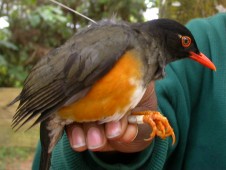
In south-east Kenya, two Critically Endangered birds, Taita Thrush Turdus helleri and Taita Apalis Apalis fuscigularis, are confined to the Taita Hills Important Bird Area (c.400 ha), where their indigenous forest habitat is reduced to small fragments. Although the surrounding land is unsuitable, studies show these endemics still manage to move between patches, revealing the importance of even tiny remnants of habitat.

The Taita Hills Important Bird Area, south-east Kenya, (total area c.400 ha), is composed of three main massifs. Each holds small fragments of indigenous forest that are now confined to relatively inaccessible hilltops and surrounded by settlements and agriculture. Two Critically Endangered birds are endemic to these forest remnants, Taita Thrush Turdus helleri and Taita Apalis Apalis fuscigularis. The land surrounding these natural forests is largely unsuitable for forest-dependent birds, but individuals of several such species, including all the two endemics, still manage to move between patches (Lens et al. 2002, Githiru 2003). As expected, there is more exchange between patches closest to each other, but movements of over 35 km have been recorded. Such studies reveal the importance of even tiny fragments of habitat in enabling the dispersal of species that depend upon such habitat. The role of fragments as “stepping stones” needs to be recognised: the management of the surrounding agricultural landscapes must ensure that these patches are not further eroded, and that linkages are, where possible, restored.
Related Sites
Related Species
References
Compiled: 2004
Recommended Citation:
BirdLife International (2004)
Important Bird Areas including habitat fragments and the surrounding matrix: an example from Kenya.
Downloaded from https://datazone.birdlife.org/sowb/casestudy/important-bird-areas-including-habitat-fragments-and-the-surrounding-matrix:-an-example-from-kenya on 22/12/2024